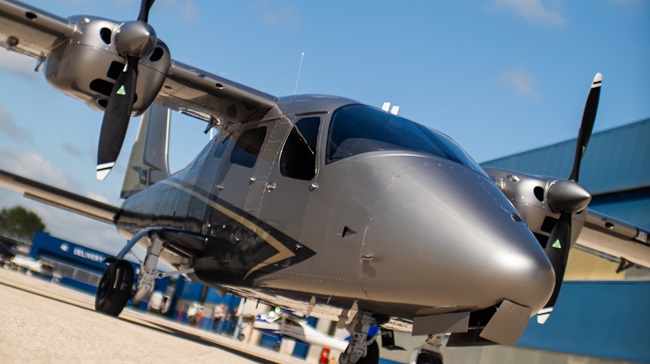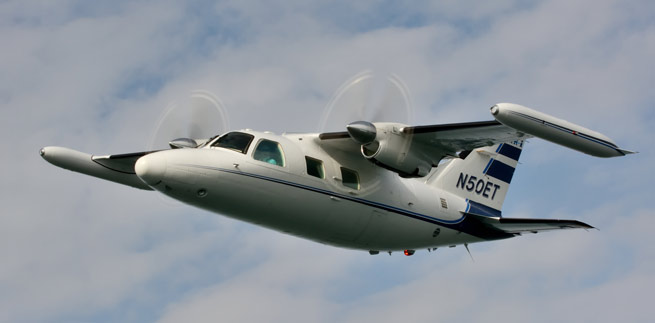
The mitsubishi MU–2—the stocky, futuristic-looking high-wing twin turboprop—marks a significant milestone this month: The model first flew in Nagoya, Japan, 50 years ago on September 14.
Mike Laver knows the date well. The pilot and aviation businessman has flown MU–2s professionally and personally for some 30 years, including 10 in his native Australia. Laver owns Air 1st Aviation Companies, Inc., based at Aiken (South Carolina) Municipal Airport, which sells MU–2 aircraft. The business also owns an MU–2 service center and operates the airport’s FBO. Since 1998, the company has provided contracted training flight services for the U.S. Air Force at Tyndall Air Force Base, using nine MU–2s that log more than 4,200 hours per year.
To commemorate the model’s anniversary, Laver plans to fly around the world in N50ET, a 1973 MU–2B-25 and the 260th Mitsubishi twin turboprop built. He plans to be in Nagoya on September 14. “I’ve done quite a lot of international flying, but I’ve never flown around the world. That’s something I’ve always wanted to do. What better time than on the MU–2’s fiftieth anniversary?”
Mitsubishi Heavy Industries conceived the MU–2 as a clean-sheet design at a time when many aircraft manufacturers were adding turbine engines to existing airframes. The model incorporates a relatively small, laminar-flow wing. Full-span Fowler flaps add lift and lower the stall speed, allowing excellent short-field capabilities. Because the flaps preclude traditional ailerons, spoilers provide roll control. Stout landing gear—based on that of the Lockheed F–104 Starfighter—allows operations from rough fields. There are two fuselage styles, the short-body Solitaire has seven to nine seats, and the long-body Marquise can seat up to 11.
The design resulted in an airplane with a fast cruise—300 knots true airspeed—and impressive, near-STOL runway performance. Range can exceed 1,000 nm. That performance and some unique handling characteristics contributed to a high accident rate, including a few high-profile mishaps. An FAA special certification review in 1983 gave the MU–2 a clean bill of health.
Email [email protected]
The perilous states of GA
A snapshot of what was really at stake as general aviation endured the worst recession in a generation
By Mark Kimberling
At the onset of the financial crisis, the frenzy in Washington, D.C., led all political discussion, as new economic buzzwords such as bailouts and stimulus became fixtures in the national vernacular. Cue the auto executives’ infamous jet visit to Congress, and GA suddenly was ensnared as a target of choice to symbolize fat cats and corporate greed in ensuing tax debates. The financial implications of this became clear at the federal level, as user fees for jets and other large-scale aviation issues reemerged. Meanwhile, far from the spotlight of D.C., beneath the radar of the 24-hour cable news machine, some of the most pivotal decisions to shape the financial future of GA were actually being made in the nation’s state capitals. With record state budget shortfalls and required balanced budgets, state governors and legislators needed to find revenue fast, and GA—with the newly skewed perception of the industry—was targeted early and often with a flurry of onerous new state tax hikes.
Armed with a passionate member base, valuable local allies, and the real picture of GA, AOPA’s State Government Affairs team crisscrossed the country—from Olympia to Tallahassee—to fight back against the potentially irreparable harm on the already ailing industry. Gradually, through countless hearings, late-night strategy calls, and speed-walking conversations with rushing legislators in the statehouse halls, these ill-conceived measures were defeated and dismantled one by one. The eventual result? Not one penny in new tax increases.
Mark Kimberling is director of AOPA state government affairs.
News from AirVenture
The terrafugia transition “roadable aircraft” (or flying car, if you prefer) flew for appreciative spectators during the afternoon airshow on July 29... Nine months after the departure of EAA President Rod Hightower, Chairman Jack Pelton says the association’s board of directors is in no rush to find a new president... Two FAA-conforming HondaJets participated in a two-ship flyby and series of maneuvers, the first time they have flown before an AirVenture crowd... Lightspeed announced the new Zulu PFX (for Personalized Flying Experience) headset, which is said to deliver noise reduction customized and adapted to a user’s ear, surroundings, and preferences... Sonex is accepting $10,000 deposits on its SubSonex personal jet kit and says it will guarantee an introductory price of $125,000 to the first 10 customers... Continental Motors says the rebranded Technify (formerly Centurion) turbodiesel engines will have gearbox times between replacement increased from 300 to 600 hours... Bendix/King is offering a plug-and-play Mode S ADS-B Out compliant transponder, the KT 74... AOPA President and CEO Craig Fuller was presented with the EAA Chairman’s Award from EAA Chairman Jack Pelton for representing the essence of EAA in the highest standard... Yves “Jetman” Rossy, in his first public performance in the United States, jumped from a helicopter with his 45-pound jet pack, and flew for the Oshkosh crowd... PS Engineering announced two new products—PAR200, a four-place intercom radio and PAC15EX, a remote-mounted intercom.
Icon Aircraft gets exemption
Can now add 250 pounds to LSA weight limit
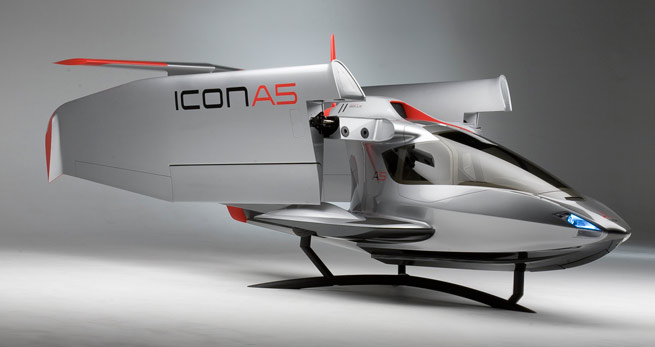
By Dave Hirschman
The FAA granted Icon Aircraft a long-sought exemption from Light Sport Aircraft weight limits to incorporate a spin-resistant design for its amphibious A5. The California firm can now add up to 250 pounds to the existing LSA weight limit of 1,430 pounds for amphibians. Icon officials say their A5 will have a gross weight of 1,510 pounds, or 80 more than the current maximum.
Icon founder and CEO Kirk Hawkins praised the FAA decision. “The FAA put safety first by allowing us to incorporate a spin-resistant design that will help avoid stall/spin accidents,” he said. “It allows us to move forward with clarity, and it bolsters the principle that adding weight shouldn’t be a barrier to safety technology.”
The production A5 will have a larger wing, bigger tail, and additional structure to support them. The weight increase will affect the A5’s performance.
Icon has taken deposits to build more than 950 aircraft. The company plans to fly its first production airplane next spring and begin customer deliveries later in 2014. The base price has increased from $139,000 to $189,000.
Email [email protected]
RedHawk flies in
Training aircraft from Redbird
By Thomas A. Horne
Redbird Flight Simulations is best known for its popular general aviation flight simulators, but the company has made a tactical shift in its business strategy. That strategy was on full display at AirVenture when a Cessna 172, remanufactured by Redbird, flew to the show and rolled up to its display. The new airplane, dubbed the RedHawk, is aimed at the training market.
Redbird and RedHawk Aero chairman Jerry Gregoire calls the RedHawk project an experiment. “We know the RedHawk will cost less to own and operate than a new airplane, but we’re not committing to hard numbers right now…we don’t know what the total market might be, and we don’t know how we’ll price the airplane.” Gregoire’s next step is to put the airplane into flight and operational tests, the results of which will be revealed at the Redbird Migration Training Conference being held in San Marcos, Texas, October 28 through 30.
Email [email protected]
Protecting pilots
AOPAIS celebrates 20 years of service
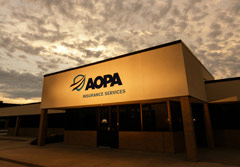 AOPA Insurance Services (AOPAIS) marked its twentieth anniversary in August, celebrating two decades of protecting pilots and the aviation community through insurance and risk-management services with a commitment to giving back to members through direct support of the AOPA mission.
AOPA Insurance Services (AOPAIS) marked its twentieth anniversary in August, celebrating two decades of protecting pilots and the aviation community through insurance and risk-management services with a commitment to giving back to members through direct support of the AOPA mission.
“I am delighted to congratulate our colleagues at AOPA Insurance Services on this noteworthy anniversary,” said Craig Fuller, AOPA president and CEO. “AOPA Insurance Services perfectly represents AOPA’s core principles through great service for our members with the goal of keeping them flying. I know the next 20 years will bring even more success.”
Launched in a partnership with Aon Insurance in September 1993, AOPA Insurance Services has since grown into a brokerage that offers coverage on a wide variety of aircraft, from historic and experimental aircraft to today’s most advanced business jets.
In 2008, the company became a wholly-owned subsidiary of AOPA and it has assumed AOPA’s other membership insurance offerings, such as term life and accidental death policies. Three of the six original employees—Gina Monarez, Cathy Knotts, and Brenda Jennings—still work for AOPAIS.
From its headquarters in Wichita, AOPA Insurance Services has expanded to offer a variety of innovative programs for pilots, including special insurance coverage for flying clubs and an accident forgiveness program. Under that program, pilots who take two AOPA Air Safety Institute online courses every six months can avoid both a deductible payment if they are involved in an accident and a premium increase when the policy is renewed.
In June 2013, AOPA Insurance Services launched a new commercial program offering coverage to members who have aviation-related businesses, such as fixed-base operators and manufacturing and repair facilities.
“The changes made over the years have come from tailoring our products to fit what our members are asking for,” said Brenda Jennings, AOPA Insurance Services senior vice president and director of operations. “In addition to providing targeted services, we are also able to right now offer members the lowest rates we have seen in the industry since the 1970s. This is a very exciting time for AOPAIS.”
In addition to providing financial support for AOPA’s mission, AOPA Insurance Service has donated $1.8 million to the AOPA Foundation since 2009 to help safeguard the future of general aviation.
AOPAIS
 Aviation insurance veteran Bill Snead has joined AOPA as president of AOPA Insurance Services, the nation’s largest insurer of light aircraft. Snead is a pilot who has 36 years of aviation insurance experience as a broker, agent, and underwriter. Snead has worked with clients in all major aviation insurance lines, including pleasure, business, and commercial aviation, Experimental, Light Sport, antique, and warbird aircraft. Snead began his aviation career with Avemco Insurance in 1977 as a sales underwriter and over the next 22 years rose to become one of Avemco’s Aviation Insurance regional managers. Most recently, Snead served as vice president of aviation insurance with Falcon Insurance. During his 14-year career at the company, he launched and managed Falcon’s Great Lakes Branch, among his accomplishments. Snead holds a commercial pilot certificate and served in the U.S. Air Force as a crew chief. He has a bachelor of science degree from Virginia Commonwealth University. Snead takes up his post as AOPA Insurance Services celebrates its twentieth anniversary.
Aviation insurance veteran Bill Snead has joined AOPA as president of AOPA Insurance Services, the nation’s largest insurer of light aircraft. Snead is a pilot who has 36 years of aviation insurance experience as a broker, agent, and underwriter. Snead has worked with clients in all major aviation insurance lines, including pleasure, business, and commercial aviation, Experimental, Light Sport, antique, and warbird aircraft. Snead began his aviation career with Avemco Insurance in 1977 as a sales underwriter and over the next 22 years rose to become one of Avemco’s Aviation Insurance regional managers. Most recently, Snead served as vice president of aviation insurance with Falcon Insurance. During his 14-year career at the company, he launched and managed Falcon’s Great Lakes Branch, among his accomplishments. Snead holds a commercial pilot certificate and served in the U.S. Air Force as a crew chief. He has a bachelor of science degree from Virginia Commonwealth University. Snead takes up his post as AOPA Insurance Services celebrates its twentieth anniversary.
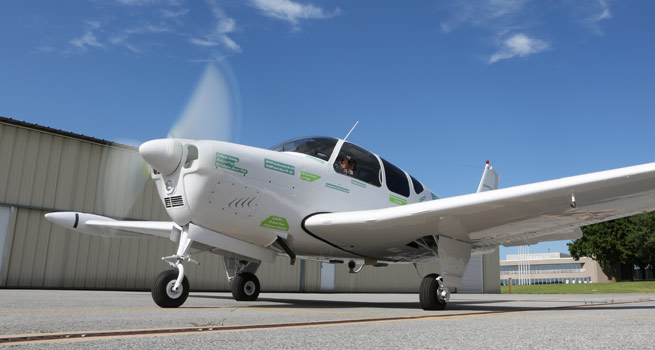
AOPA Sweepstakes: Paint in progress
All-white with decals at first, stripes later
By Thomas A. Horne
Want to spiff up a doggy-looking car, boat, or house? The fastest way is to slap on a fresh coat of paint. So it is with our sweepstakes Beechcraft Debonair. A little research turned up the fact that its paint job was original. Folks, that faded yellow paint is 50 years old! Actually, I should use the past tense, because the old paint was stripped off, the airplane surfaces cleaned, and exterior repairs performed—all in preparation for the airplane’s first paint job.
KD Aviation, based at Trenton-Robbinsville, New Jersey, and Stewart International Airport in Newburgh, New York, is doing our paint work. KD, run by brothers Ken and Don Reese, have done exemplary work on previous sweepstakes airplanes, namely the 2004 Win-A-Twin Twin Comanche and the 2000 Millenium Mooney projects. But with the Debonair Sweepstakes, the paint plan takes a twist.
The airplane will be painted in two stages. First, in preparation for the 2013 EAA AirVenture in Oshkosh, the airplane will be given a coat of solid Matterhorn White. No stripes, no swoopy bands of color. Just plain white. Well, not exactly plain. We’re adding decals that describe the equipment and other improvements we’ve made to the airplane over the past year. There are also historical facts and trivia adorning the paint job. Some relate to the world of 1963, the year of the Debonair Sweepstakes’ birth. The all-white paint scheme will remain on the airplane until the end of the year. That’s when the decals come off and the stripes and bands of the final scheme are added. This means that at AOPA Aviation Summit in Fort Worth, Texas, October 10 through 12, you’ll still see the white-and-decals treatment. But for next year’s shows and other events, the final scheme will be in place.
Which brings up the online opinion poll we ran a few months ago. Seems most of you liked the number-four red-and-black scheme, with the number-six yellow-and-black scheme coming in second. In third place was scheme number two, drawing 539 votes.
The subtle blue-dominant tones of the number-two scheme was our choice. Mike Kline, our creative director, had two main objectives in mind when he proposed the scheme. One was to make the color compatible with the colors in the Debonair Sweepstakes logo. Equally important was to retain elements of the original 1963 Beech paint scheme—the angular, “arrowhead” motif at the leading edges of the wide paint stripes. Add in the more modern elements of the design provided by Craig Barnett’s Scheme Designers, and there you have it. Oh, and the whole motif is echoed in the propeller paint scheme, done by American Propeller of Redding, California.
It’s a great new look for any classic Beechcraft of that era, and we felt it suited the Debonair brand especially well. Join AOPA or renew your membership for a chance to win. The airplane will be delivered at AOPA Summit 2014.
Email [email protected]
Did you know...
- The average car sold for $3,200 in 1963?
- That gas cost 29 cents a gallon?
- That the Piper Twin Comanche, Mitsubishi MU–2, and Lear 23 made their debuts that year?
- That the average annual income was a whopping $5,800?
>>Watch a time-lapse video of the painting process.
Moosehead Lake hosts fly-in
Set for September 5 through 8 in Maine
This year commemorates the fortieth anniversary of the International Seaplane Fly-In at Greenville on Maine’s giant Moosehead Lake. This granddaddy of all water-flying extravaganzas has grown from a gathering of a couple dozen like-minded water pilots to the largest attraction of its type in the world. Each September it attracts some 200-plus seaplanes to Greenville, plus an additional 300 or more landplanes to the Greenville airport, where hundreds of tents blossom under the wings of tied-down aircraft as their camping owners revel in the crisp Maine air. Aircraft have attended from many foreign countries, including Russia. Spectators numbering in the thousands line the grounds of the Maine Department of Inland Fisheries and Wildlife’s regional headquarters, where the fly-in has been held since its inception in 1973. The department has always offered free use of its grounds and hangar, which is crowded with vendors’ and organizations’ booths.
For more information, visit the website (www.seaplanefly-in.org) or call 207-695-2928.
Make it Memphis
When you’re in the mood for blues and BBQ

By Dave Hirschman
The next time you’re near the Mississippi River and in the mood for blues music or barbeque (that’s pretty much a permanent condition for some of us!), do yourself a favor and drop into Gen. DeWitt Spain Airport (M01) near downtown Memphis, Tennessee (above).
This general aviation gem is literally on the banks of the river just north of the Interstate 40 (a.k.a. “Dolly Parton”) bridge. A 10-minute cab ride to downtown Memphis gets you to:
- Beale Street blues clubs
- The National Civil Rights Museum (at the infamous former Lorraine Motel)
- Grizzlies NBA basketball and Redbirds minor league baseball stadiums
- Fantastic food (The Cupboard and Little Tea Shop are local favorites)
- Graceland, Elvis Presley’s former home, is about 30 minutes away
The nontowered airport is home of the Commemorative Air Force’s Memphis Wing, and the group flies an extremely impressive Sea Fury as well as numerous World War II-era trainers; EAA Chapter 182 also has its hangar there.
The scenic airport was nearly washed away by a devastating 100-year flood in 2011, and airport buildings were submerged by floodwaters more than six feet deep. Fortunately, aircraft owners and businesses had advance warning and were able to evacuate airplanes and equipment, and they rebuilt with tremendous dedication and effort.
There’s never a bad time to drop in, but Memorial Day weekend is, perhaps, the very best. A month-long celebration called the Memphis in May International Festival ends with an outdoor “Sunset Symphony” concert on the river along with an airshow featuring an array of warbirds and aerobatic performances.
Email [email protected]
- Gen. DeWitt Spain Airport (M01) operated by the Shelby County Airport Authority
- 901-358-0028
- Self-service fuel
- 24-hour taxi service
- Rental cars: www.aopa.org/cars
- 866-315-9155
High adventure at jamboree
General aviation and scouting make a good match
By Dan Namowitz
 When the Boy Scouts of America promised participants in the 2013 National Scout Jamboree “high adventure like you’ve never seen” for 10 days in the mountains near Mount Hope, West Virginia, AOPA was there to help deliver that adventure by introducing scouts, volunteers, and staff to general aviation. The introductions to aviation came from none other than AOPA President Craig Fuller and Senior Editor Dave Hirschman.
When the Boy Scouts of America promised participants in the 2013 National Scout Jamboree “high adventure like you’ve never seen” for 10 days in the mountains near Mount Hope, West Virginia, AOPA was there to help deliver that adventure by introducing scouts, volunteers, and staff to general aviation. The introductions to aviation came from none other than AOPA President Craig Fuller and Senior Editor Dave Hirschman.
“I travel the country talking to pilots and AOPA members, but even I rarely get to see so much enthusiasm from so many young people as I have today at the Boy Scouts of America National Jamboree,” said Fuller. More than 4,000 scouts visited AOPA’s tent at the jamboree, with many trying their hands at a flight experience at the controls of the AOPA Jay flight simulation device by Redbird. Some 600 scouts signed up for AOPA’s special AV8Rs membership program, available to teens ages 13 to 18, Fuller said.
In keeping with the Airborne Day theme on July 18, all eyes took to the sky as an RV flyover led by Hirschman soared above The Summit, the 10,600-acre site of the jamboree, in the New River Gorge National River area.
The 2013 Jamboree, which was held July 15 to July 24, drew 50,000 participants as the event debuted in its new permanent home at the West Virginia site.
>>View a video of the jamboree.
Notice of annual meeting to members
The annual meeting of the members of the Aircraft Owners and Pilots Association will be held at 12 noon on Friday, September 6, 2013, at the headquarters of AOPA, 421 Aviation Way, Frederick, Maryland 21701, located on the Frederick Municipal Airport (FDK), for the purpose of receiving reports and transacting such other business as may properly come before the meeting, specifically including the election of trustees. —John S. Yodice, Secretary
AOPA wins awards
The media and outreach departments of AOPA were recognized at the 33rd annual Association Media and Publishing EXCEL Awards Gala in Washington, D.C.
Association Media and Publishing is a Washington-based organization representing associations in the United States. EXCEL awards are bestowed on the finest media products and publications in the association industry.
AOPA was given a Gold Award in the Media Kits category for “One Network: Endless Opportunities.” The judges said, “Presentation is impressive…content is easy to navigate. The images are beautiful…production quality outstanding.”
AOPA won a second Gold Award in the Media Innovation category for its “AOPA Favorite Aircraft Challenge” contest. The judges concluded: “Very creative concept that generates interest and engagement. The theme and logo tie everything together nicely.”
AOPA also received a Bronze Award for Magazine Redesign for AOPA Pilot magazine. A second Bronze Award in the Convention Marketing Campaign category was awarded to AOPA for its Aviation Summit 2012 marketing portfolio.
The 2013 EXCEL awards competition included 968 award entries submitted by 75 associations and industry professionals. Some 166 awards were presented.
Suddenly, Continental Motors has full diesel line
By Alton K. Marsh
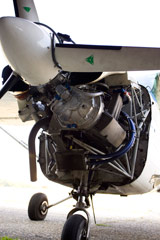 AVIC, the Chinese parent company of Continental Motors and Cirrus Aircraft, purchased the assets of bankrupt Thielert Aircraft Engines in Germany. In addition to the TD300 230-horsepower diesel engine Continental certified in December 2012, Continental can now offer a 135-, 155-, and maybe a 350-horsepower diesel engine. Thielert was testing the larger engine on several Cessna 206 aircraft in Europe prior to bankruptcy.
AVIC, the Chinese parent company of Continental Motors and Cirrus Aircraft, purchased the assets of bankrupt Thielert Aircraft Engines in Germany. In addition to the TD300 230-horsepower diesel engine Continental certified in December 2012, Continental can now offer a 135-, 155-, and maybe a 350-horsepower diesel engine. Thielert was testing the larger engine on several Cessna 206 aircraft in Europe prior to bankruptcy.
Thielert was required, under German bankruptcy laws, to establish a separate company, Centurion, for distribution and warranty work while in bankruptcy.
“Continental has a full family of engines,” said Continental President Rhett Ross. “All engines, gasoline or diesel, will be marketed under the Continental brand and can be ordered directly from us. We will be working over the next few weeks to better integrate sales and support functions so that we can operate on a global basis.
“All diesel engines will (including the currently labeled TD300) be marketed under the Centurion name. Our gasoline [engines] will continue to be marketed with the good old O/IO/TSIO moniker. We have some work to figure out how to rationalize cubic inches and liters with the Centurion, but that is coming,” Ross said.
There were 24 bidders for Thielert in 2008, but when the economy fell worldwide, the auction process was delayed. In the meantime, Continental bought Safran SMA first-generation technology and developed its own engine, using parts made by Continental. SMA was created in 1997 by Socata and Renault Sport (racing engines) in France and was sold to Safran in 2005. Second-generation diesel technology developed by SMA was chosen by Cessna Aircraft for its Cessna 182 JT-A engine. Deliveries were to start this summer.
Email [email protected]
Better, cheaper option
Garmin’s new non-TSO radio
By Dave Hirschman
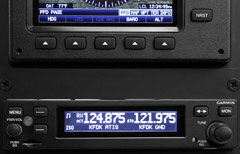 Garmin’s new GTR 200 radio gives Experimental and Light Sport aircraft better, cheaper options than FAA-certified equipment.
Garmin’s new GTR 200 radio gives Experimental and Light Sport aircraft better, cheaper options than FAA-certified equipment.
The panel-mount unit is the same physical size as the SL40 radio it replaces, and the GTR 200 adds big numbers and “3D audio.” The new radio also retains popular features such as standby frequency monitoring and a built-in intercom. And with a retail price of $1,199, it’s far less expensive than FAA-approved models.
“Our dedicated ‘Team X’ has done it again,” said Carl Wolf, Garmin vice president for aviation sales and marketing, referring to the small group of company engineers that produce experimental avionics. “The GTR 200 is the ideal solution, combining a powerful 10-watt radio with excellent sound quality and innovative features.”
The GTR 200 also “talks” to the Garmin G3X PFD/MFD and gets radio frequencies from its database. Tune in 124.875 on the radio, for example, and the frequency is identified as KFDK ATIS. Search for Nearest Airport on the G3X and frequencies can be transferred to the GTR 200 with the push of a single button, a move that lightens pilot workload and helps avoid mistakes.
GTR 200 deliveries are scheduled to begin in August.
Email [email protected]


